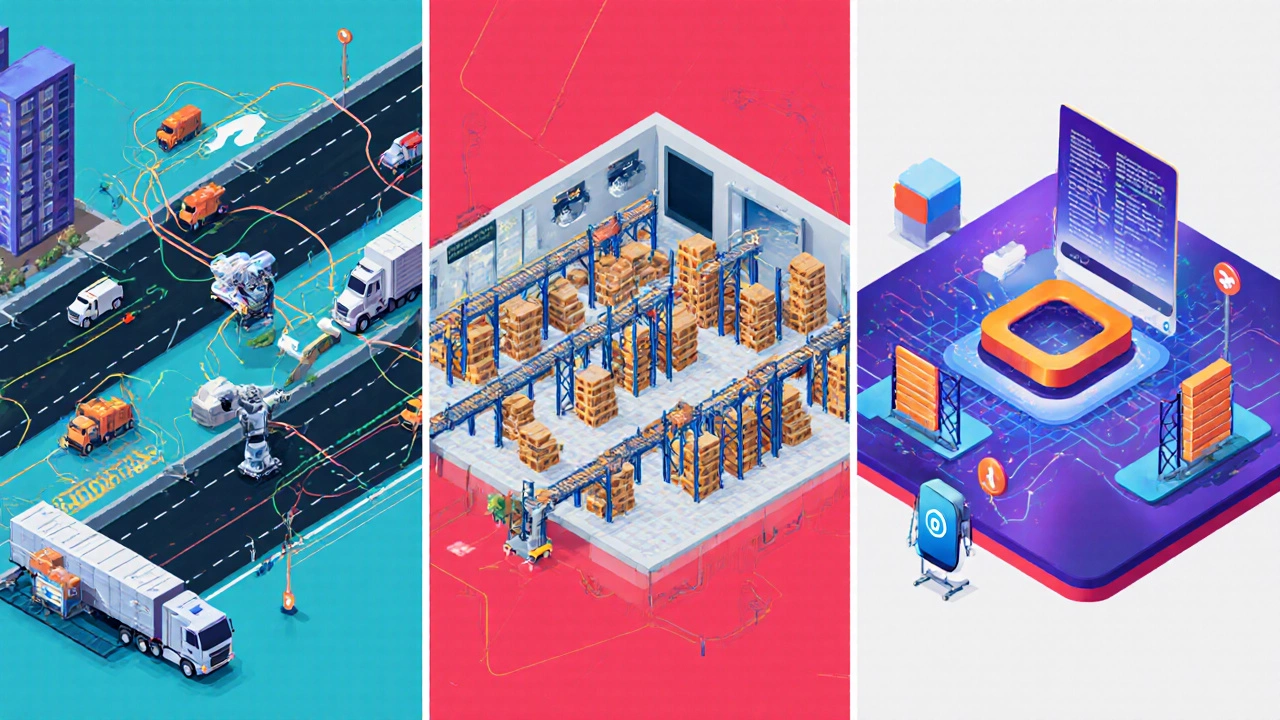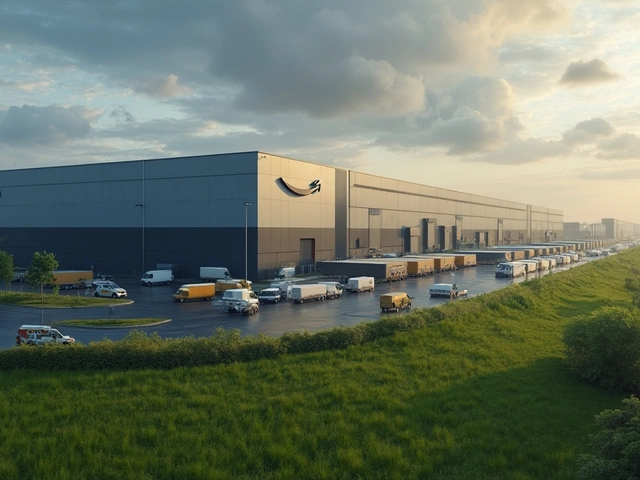Logistics Software Selector
Find Your Perfect Logistics Solution
Answer a few questions to get personalized recommendations for logistic software that fits your business size, needs, and budget.
Key Takeaways
- Logistic software includes TMS, WMS, OMS and more, each solving a specific supply‑chain problem.
- Popular names range from SAP Transportation Management to Manhattan Associates WMS.
- Choosing the right tool depends on business size, shipment volume, and integration needs.
- Implementation success hinges on clear goals, data quality, and staff training.
- A quick comparison table helps spot the best fit based on features, pricing and target users.
When you search for "what is the name of logistic software?" you’re probably trying to figure out which tools actually exist and how they differ. The short answer is that there isn’t a single product - the market is split into several families, each with its own set of well‑known names. Below you’ll find a plain‑English walk‑through that defines the main families, lists the most widely‑used solutions, and gives a side‑by‑side comparison so you can pick the one that matches your operation.
What Is Logistic Software?
Logistic software is a suite of digital tools that help businesses plan, execute, and monitor the movement of goods from suppliers to customers. It replaces spreadsheets, phone calls, and manual paperwork with automated processes, real‑time visibility, and data‑driven decisions. The software can live in the cloud, on‑premises, or as a hybrid, and most modern platforms expose APIs for integration with ERP, e‑commerce, or accounting systems.
Core Families of Logistic Software
Think of logistics as a puzzle with several pieces. Each piece has a dedicated software family:
- Transportation Management System (TMS) optimizes route planning, carrier selection, freight tendering, and shipment tracking.
- Warehouse Management System (WMS) controls inbound receiving, put‑away, picking, packing, and inventory counts inside a warehouse.
- Order Management System (OMS) orchestrates order entry, allocation, fulfillment, and returns across multiple sales channels.
- Route Optimization Software focuses solely on calculating the most efficient delivery routes for fleets.
- Inventory Management Software maintains real‑time stock levels, safety stock rules, and demand forecasting.
- Supply Chain Visibility Platform aggregates data from TMS, WMS, IoT sensors and provides end‑to‑end tracking for stakeholders.
- Yard Management Software manages truck movements in loading bays, dock appointments and gate control.
Each family can be a standalone product or part of an integrated suite. Small businesses often start with a cloud‑based TMS or WMS, while large enterprises look for a unified platform that covers all families.

Popular Logistic Software Names
Below are the most frequently‑mentioned solutions in 2025. The list mixes global giants and niche players, giving you a sense of the breadth of the market.
- SAP Transportation Management Enterprise‑grade TMS that integrates tightly with SAP ERP and S/4HANA, offering carrier‑rate management, freight settlement, and AI‑driven route optimization.
- Oracle Transportation Management Cloud‑based TMS with global compliance, multi‑modal planning, and a large carrier network.
- Manhattan Associates WMS Highly configurable warehouse platform known for its wave‑picking engine and advanced labor management.
- Blue Yonder Luminate Platform Supply‑chain visibility suite that combines demand forecasting, inventory optimization, and real‑time transport visibility.
- Descartes Systems Group Cloud logistics network offering route planning, customs compliance, and freight forwarding modules.
- Project44 Connection‑focused platform that provides API‑driven shipment tracking across carriers worldwide.
- FourKites Real‑time visibility platform that aggregates data from TMS, WMS, and IoT devices for end‑to‑end tracking.
- ShipBob Mid‑size e‑commerce fulfillment solution that bundles WMS, OMS and last‑mile delivery into a single cloud service.
These names appear in most analyst reports and buyer guides. If you’re evaluating software, you’ll likely encounter at least a few of them during demos or RFPs.
Quick Comparison Table
| Software | Primary Focus | Typical Users | Deployment | Pricing Model |
|---|---|---|---|---|
| SAP Transportation Management | TMS + Freight Settlement | Large enterprises, global manufacturers | Cloud & On‑prem | License + subscription |
| Manhattan Associates WMS | Warehouse Operations | 3PLs, retail distribution centers | Cloud (SaaS) | Subscription per dock |
| Blue Yonder Luminate | Supply‑chain visibility & forecasting | Supply‑chain planners, C‑level | Cloud | Usage‑based tiered |
| Project44 | Shipment tracking API | Shippers, freight brokers | Cloud SaaS | Pay‑per‑track or subscription |
| ShipBob | End‑to‑end fulfillment for e‑commerce | SMBs, DTC brands | Cloud (managed fulfillment) | Fee per order + storage |
The table shows where each product shines. For example, if you need advanced labor planning inside a 150‑slot warehouse, Manhattan’s WMS is a natural fit. If you’re a fast‑growing DTC brand looking for a plug‑and‑play fulfillment service, ShipBob cuts the setup time dramatically.
How to Choose the Right Logistic Software
Picking a tool is less about brand hype and more about aligning features with business objectives. Use the following checklist:
- Scope of operations: Do you need only transportation planning, or a full suite covering warehousing, inventory, and visibility?
- Integration landscape: Does the software offer native connectors for your ERP (e.g., NetSuite, Microsoft Dynamics) or e‑commerce platform (Shopify, Magento)?
- Scalability: Can the solution handle a 30% YoY growth in shipments without major re‑architecture?
- User experience: Field staff need mobile‑friendly interfaces; planners need dashboards with drill‑down.
- Pricing transparency: Identify recurring subscription fees versus hidden transaction costs (e.g., per‑load, per‑track).
- Support & training: Look for implementation services, online knowledge base, and local support if you operate in regions like Oceania.
Run a pilot with a limited carrier or a single warehouse before committing enterprise‑wide. The data you collect during the pilot-cycle‑time improvement, cost savings, error reduction-will justify the ROI to finance.

Implementation Tips & Common Pitfalls
Even the best software can flop if you ignore execution basics. Here are proven steps:
- Define clear KPIs: On‑time delivery, dock‑to‑stock time, and transportation cost per unit are measurable targets.
- Clean your data: Inaccurate address databases or outdated carrier contracts lead to poor routing results.
- Map existing processes: Document current workflows so you can spot gaps that the new system will fill.
- Engage end‑users early: Drivers, warehouse leads, and planners need hands‑on sessions to adopt the UI.
- Set up integration middleware: Use a robust API gateway or iPaaS to keep ERP, CRM, and finance data in sync.
- Phase rollout: Start with a single region or product line, then expand after verifying stability.
- Monitor and iterate: Use the software’s analytics to fine‑tune carrier contracts and route parameters every quarter.
A common mistake is to try to replace every legacy system at once. That creates massive change‑management overhead and often results in data loss. Incremental migration keeps the supply chain humming while you transition.
Frequently Asked Questions
What is the difference between TMS and WMS?
A TMS (Transportation Management System) focuses on moving goods between locations - route planning, carrier selection, freight audit, and shipment tracking. A WMS (Warehouse Management System) manages what happens inside a warehouse - receiving, put‑away, picking, packing, and inventory control. They often integrate, but each solves a distinct set of problems.
Can I use a single platform for all logistics functions?
Yes, many vendors now offer unified suites that bundle TMS, WMS, OMS and visibility tools. Examples include SAP Logistics Business Network and Blue Yonder Luminate. However, the breadth can come with higher complexity, so assess whether you truly need every module or can start with a best‑of‑breed approach.
Is cloud‑based logistic software safe?
Modern cloud providers follow ISO 27001, SOC 2 and GDPR/CCPA standards. Look for certifications, data‑encryption at rest and in transit, and role‑based access controls. Many companies also offer private‑cloud or hybrid options for added governance.
How much does logistic software typically cost?
Pricing varies widely. SaaS solutions often charge a base subscription (e.g., $5‑$15 per user per month) plus usage fees like $0.10 per shipment. License‑based enterprise suites can start at $50,000-$100,000 upfront plus annual maintenance. Always ask for a detailed cost‑to‑value model during negotiations.
Do I need custom development for integration?
Most leading platforms provide standard connectors for ERP, e‑commerce, and accounting systems. If your stack includes niche tools, a small amount of middleware (often Zapier‑style) or bespoke APIs may be required, but the goal should be to keep custom code under 10% of the total solution.
Next Steps & Troubleshooting
If you’re ready to start evaluating, follow this short path:
- Step 1 - Audit your current processes: Write down every logistics touch‑point and the pain points you face.
- Step 2 - Prioritize features: Use the checklist above to rank TMS, WMS, visibility, etc., by importance.
- Step 3 - Shortlist vendors: Pick 3‑4 names from the list that match your priority and request a demo.
- Step 4 - Run a pilot: Implement the software for a single warehouse or route, track KPI changes for 30‑60 days.
- Step 5 - Full rollout: Expand based on pilot results, adjust configurations, and train all users.
Common troubleshooting scenarios include mismatched carrier codes, GPS data gaps, and inventory count discrepancies. Most vendors offer a knowledge base and live chat; however, keeping an internal “logistics champion” who knows the data model can dramatically reduce resolution time.
Now you have a solid map of the logistic software landscape, a handy comparison table, and a clear action plan. Whether you’re a startup looking for a simple TMS or a multinational needing an integrated supply‑chain suite, the names and criteria above will guide you to the right choice.





